Nikita Parris came into this FIFA Women’s World Cup as one of England’s star players, tasked with spearheading the attack. Parris has not disappointed and led the Lionesses to three wins from three to top their group that included former World Cup champions in Japan. The England winger has been instrumental to England’s success in qualifying and will be as important if they are to make their way deep in the tournament.
Parris has already won every domestic title with Manchester City and has become an England regular at the age of 25. Towards the end of 2018, Parris became the all-time leading goal scorer in the Women’s Super League, eclipsing Eni Aluko’s 36 goals. Her enthusiasm and dedication to the game was never in doubt as she spent hours watching DVDs on Thierry Henry.
As a teenager, she sat her GCSE’s at one of England’s training camps invigilated by one of the coaches. By day, she would train with her school athletics team but as the darkness began to descend Parris played football with a group of kids from the local area. Even playing with boys almost six years older, she was never intimidated by the challenge and was determined to become a footballer.
After witnessing her impressive performances throughout the season, it begs the question, who is Nikita Parris? In this tactical analysis, we aim to showcase the qualities that earmarked her as England’s brightest prospect of making a mark at the FIFA Women’s World Cup.
Nikita Parris is a natural right winger who possesses incredible speed, guile, and ability on the ball. She has been a consistent goal scorer for Manchester City becoming their attacking figurehead. Off the back of her incredible performances with City last season, Parris earned herself a move to Olympique Lyonnais Féminin, arguably the best club side in women’s football.
Her consistency and influence caught the eye of the six-time Champions League winners. She now joins an elite group of players in hopes of winning the coveted European trophy. The statistics from her last season saw her rack up 1,600 minutes across 19 appearances with a goal return of 19. A goal a game for a winger is most impressive. Through this analysis, we will able to further understand how England have profited.
Transitional play
Parris’ ability isn’t just isolated to the final third but also her exceptional link-up play being a particular highlight. The England international’s movement into the middle third creates an extra body during transitions and defensive situations. Her nimble touch allows her to get the ball out of her feet to interchange quick passes with England’s deeper players. Phil Neville wants his team to play quick, exciting football through transitions from back to front and Parris is a testament to his style of play.
Her intelligent movement is borne by her excellent positioning between the lines. Not only does she create space for her teammates but the ability to give herself time is impressive. Her relationship with Bronze is a particular highlight and has been a feature of England’s play in the FIFA Women’s World Cup.
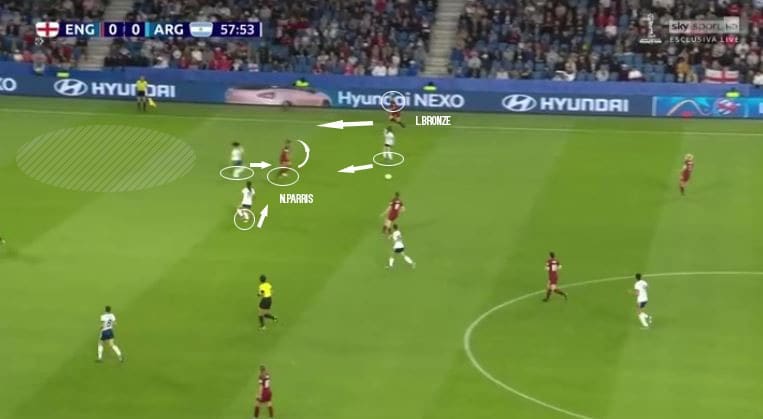
As the graphics above highlight, Parris’ positioning allows her to dictate the opposition’s movement by creating openings for her teammates. In this situation, Parris’ deeper position has her pressed by three Argentine players including the full-back. This has given Bronze an opening in the highlighted space down the right flank. A deft touch from the Liverpool born forward immediately takes out the three aforementioned Argentine players giving England the attacking advantage.
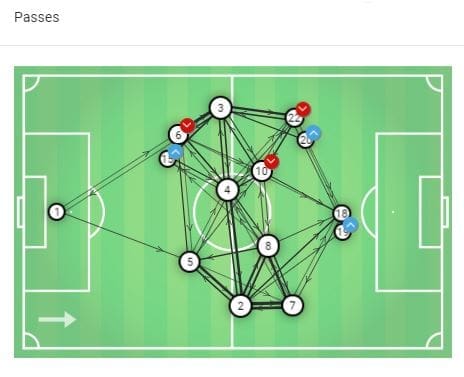
The below example is a perfect example of Parris’ ability to create space for midfield runners by positioning herself between the lines. As she drops deep to provide a pass to Bronze, two Scottish players immediately surround her. However, her pass back to the Lyon right-back opens up space in behind for Jill Scott to occupy and make a run. Even though the pass didn’t reach its intended target, Parris’ influence was evident.
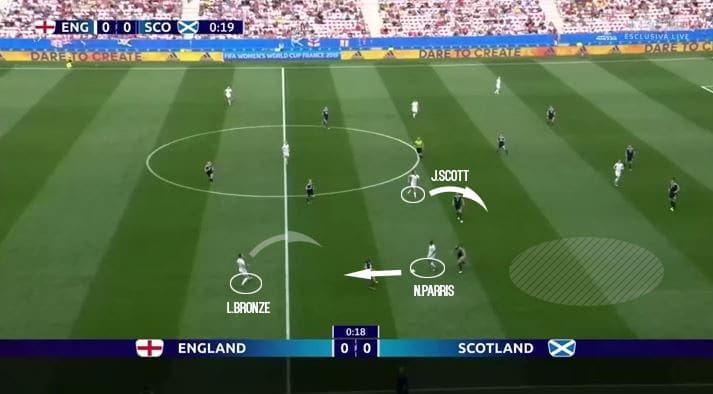

Cognitive processes
Parris’ intuitiveness allows her to manipulate and create space through her intricate thought processes. With a slender physique and high footballing IQ, Parris is perfectly suited to playing as a winger. This allows her to weave between defenders and wreak havoc in the opposition penalty area. She makes smart moves in and around the final third and touchline usually beating her defender in one v one situations. This enables her the best possible chance to move the ball forward resulting in more space to operate in.
Parris is very aware of her surroundings which makes her decision-making ability to cut inside or stay out wide very important, however, she does struggle to convert her good positions into clear cut opportunities. Her playstyle revolves around dropping into midfield to collect passes and working in the half-spaces. This makes it difficult for the opposition to track her movements and allows Lucy Bronze to make marauding runs on the overlap.
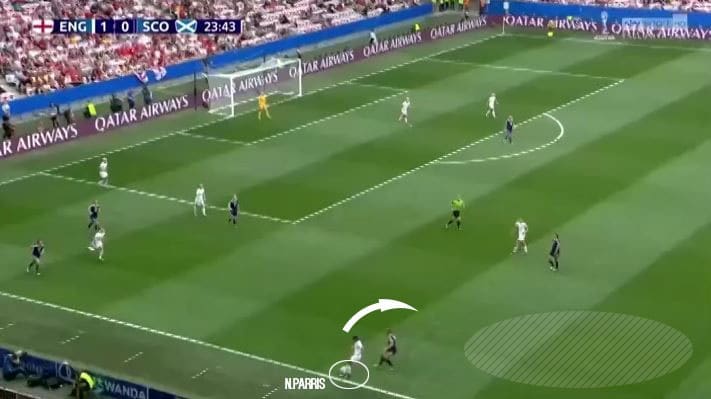
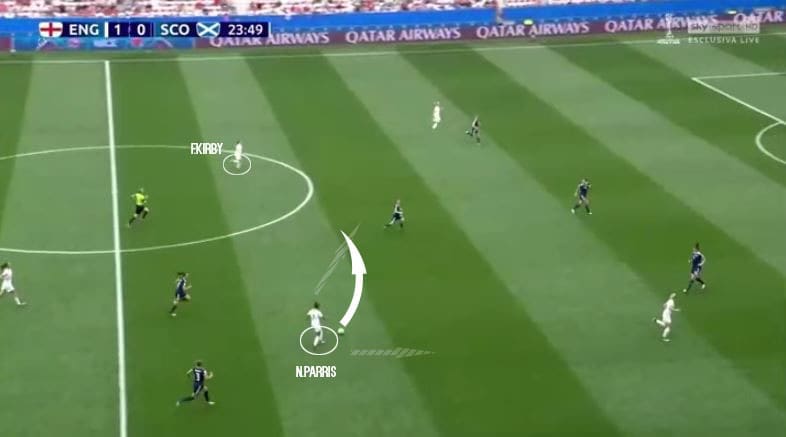
As the graphics show, Parris dropped deep to provide her defender with a passing option. With her back to goal, she will need to manoeuver herself towards Scotland’s goal and utilise the empty space in behind. As she receives the ball from Bronze, she takes a deft touch to take it past the Scottish left-back exploiting the acres of space behind her. Parris is able to dribble deep into Scotland’s half where she has a couple of passing options. She shows her intelligence by picking out Fran Kirby on the far side instead of Ellen White or Beth Mead. Passing to the England striker could have cornered her allowing Scotland to regroup defensively.
On the byline, Parris utilises her immense speed and touch to get away from defenders. In the image below, Parris has been given an extra yard of space to work in. This gives her the opportunity to leave the Argentine defender behind and put in an excellent cross that is unfortunately cut out.
This sort of dribbling ability adds more pressure on opposing defences as it prompts teams to switch focus on Parris. This allows the likes of Kirby, Scott and Toni Duggan to navigate themselves into goalscoring positions. This example exemplifies her ability to excel in different situations that not only benefits her own game but that of the team.
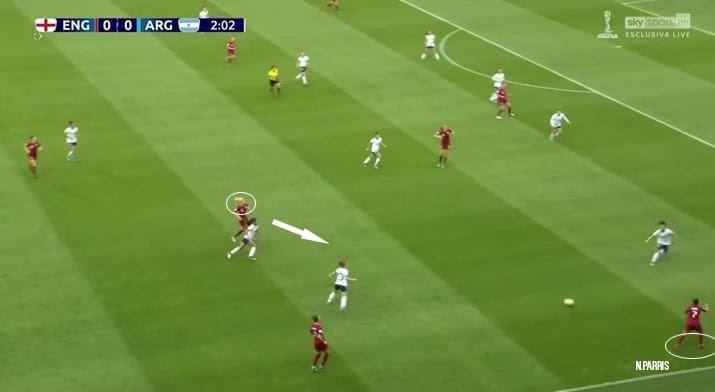
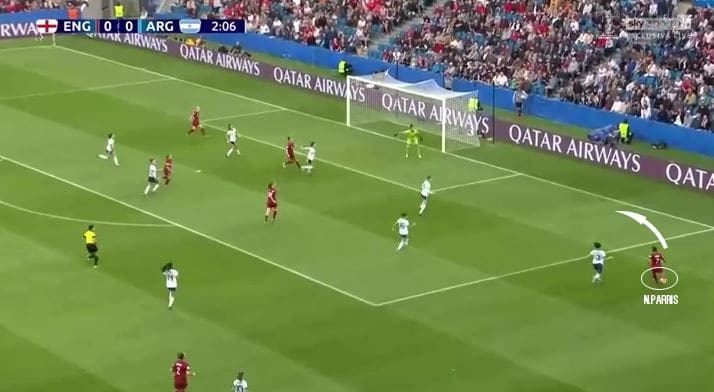
However, there are deficiencies in her attacking play on the international stage. Her conversion rate in the final third could improve. During the group stages of this summer’s World Cup, Parris attempted 18 dribbles successfully completing 14, however, it yielded a pitiful success rate of five crosses. These statistics point towards her inconsistent concentration and decision making in the final third. Her build-up play and cognitive process in dribbling is exceptional yet she has struggled to make a real impact for England just yet because of this. This has ultimately affected her overall output.
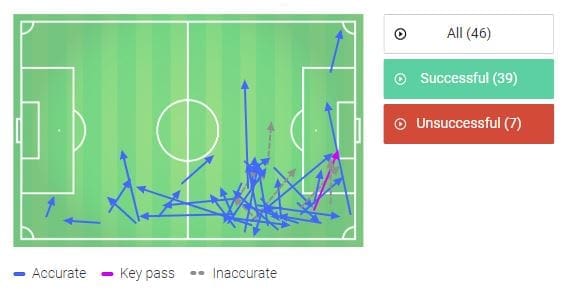
This pass map against Scotland indicates that she gets into threatening positions quite often but is often isolated against the full-back even with her superior speed and dribbling ability. England’s 4-3-3 formation requires to stay wide. At Manchester City, she often utilised more centrally as a centre-forward allowing her more time in possession whilst dictating play from deeper central positions. Teams in England play infrequently which doesn’t give the opposition teams an opportunity to test themselves against the likes of Parris week in week out making it harder to stop her.
Penalty box predator
Whilst Parris is a goal machine for her club, her FIFA Women’s World Cup campaign has been underwhelming. The Lyon forward has scored one penalty in England’s last four matches but scored six in six in World Cup qualifying. The opposition have been wary of her partnership with Bronze down England’s right-hand side and as a result, have tactically prepared themselves to close her down. Teams are playing with a much more compact defensive line and using midfield support to keep their right flank pre-occupied and shut down. However, she does possess a clinical finishing ability even under pressure from the opposition especially if they suffer a lapse in concentration.
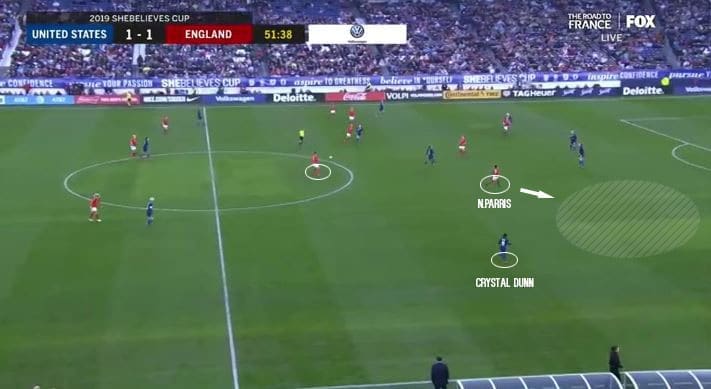
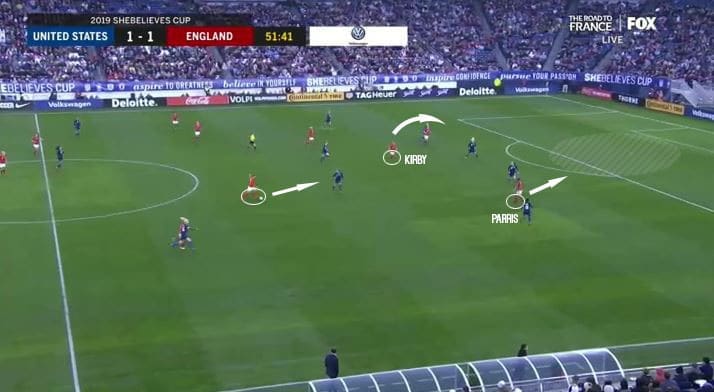
As the graphics above highlight, Parris starts in a deep position looking to push forward as England advance the ball in midfield. She recognises the gap left by the United States left-back, Crystal Dunn and asks for possession. The pass into Fran Kirby distracts the opposition defenders and allows her to ghost through to capitalise on the unoccupied space between the full-back and centre-back.
On numerous occasions, Parris has been at best clinical best for Manchester City, scoring goals whilst under pressure from multiple players. Parris receives a variety of passes from her Manchester City teammates, as she breaks the opposition lines to accelerate into the penalty area but is at times quickly pressured by the centre-back(s) and goalkeeper. The English winger can often be limited to her shot placement because of the confined space but usually makes the correct decision.
Leading the pack
This tactical analysis has given us enough evidence of this Lioness’ potential to rival the current Ballon d’Or holder Ada Hegerberg. After achieving everything there is to win at Manchester City, her move to Lyon is a testament to her abilities as a footballer and should propel her to even bigger heights. Competing against the best teams in the Champions League on a regular basis should significantly improve her skills. Parris has shown flashes of brilliance at the FIFA Women’s World Cup and has given fans a taste of what’s to come after her performances with Bronze. Parris has become the face of English football, however, she is yet truly roar but if England needs a saviour against Norway then you can bet on Parris leading the pack when it’s they’re down.
If you are following the FIFA Women’s World Cup 2019 then you will find our FREE tactical preview magazine the perfect compliment to the tournament. You can download it HERE – each nation is previewed and we also profile their key player and young player to watch. Enjoy!

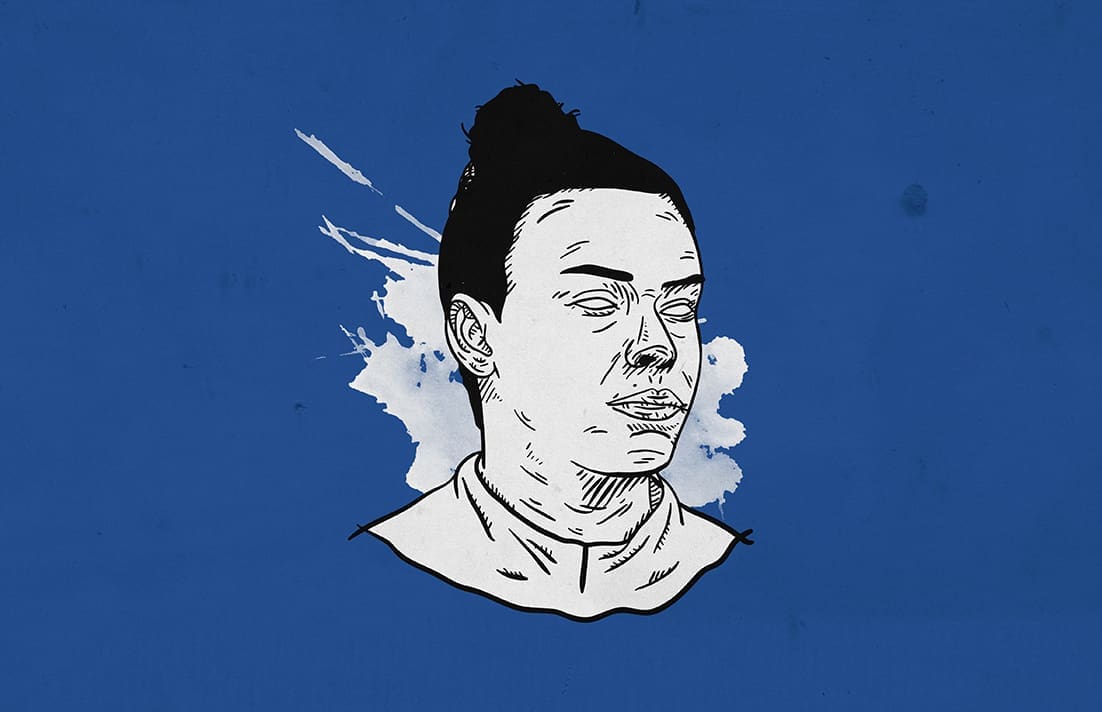



Comments